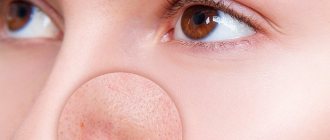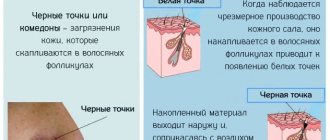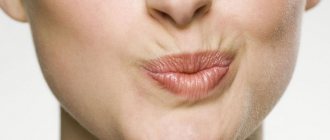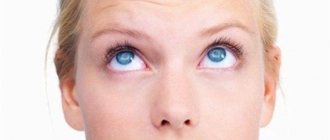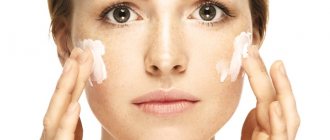Skin pigmentation: main causes and methods of correction
A pigment spot is an area of excessive accumulation of melanin, a special pigment found in various layers of the epidermis. When it is deposited in the upper layer of the skin, small spots (for example, freckles or moles) form. They can be from light yellow to brown and, in most cases, do not cause much trouble or worry to their owner.
Hyperpigmentation, which is deposited in the deeper layers of the epidermis, looks completely different - dark brown spots appear on the surface of the skin (they can rise above the surface of the skin). Such pigmentation upsets women more, and in some cases, it really bothers them.
Age spots can appear in both young girls and women over 50. As a rule, their appearance is more likely over the age of 35-40. In isolated cases, they go away spontaneously; more often, getting rid of them requires considerable effort.
Doctors distinguish the following types of pigmentation:
- freckles;
- chloasma;
- lentigo;
- birthmarks (moles).
Reasons for increased melanin synthesis:
- Hereditary (genetic) factor. It is the result of a genetic predisposition and is usually diagnosed at birth. Severe pigmentation can be treated with modern surgical techniques (for example, laser resurfacing);
- Hormonal changes in the body. Such pigmentation can be quite noticeable and is a consequence of hormonal changes associated with the menstrual cycle, pregnancy, the postpartum period, and hormonal imbalance due to any disease. The pigmentation is called chloasma. Experts do not recommend self-treatment in this case, since it is important to accurately establish the diagnosis and conduct a course of treatment for the underlying disease;
- Mechanical damage to the skin. The formation of pigment spots as a result of attempts at illiterate treatment of acne, with chronic and severe furunculosis, due to exposure to chemical and thermal factors (burns), as well as in violation of the protocols for certain cosmetic procedures (chemical peeling, laser resurfacing, etc.). The intensity varies significantly and directly depends on many components - the characteristics of the skin of a particular patient, the degree and depth of injury;
- Aggressive exposure to ultraviolet radiation. Pigment spots of this type are provoked by aggressive exposure to sunlight or other sources of ultraviolet radiation. They often appear on the face, since the skin of this area of the body is the thinnest and most vulnerable;
- Skin aging. At a certain age (after 40-50 years and older), some people develop characteristic age spots, which are located on the face, neck, and hands. This is the result of the active synthesis of melanin and a consequence of its uneven distribution in the layers of the skin, as well as changes in hormonal balance and natural aging of the body, and the skin in particular. In addition, pigmentation at this age can be a consequence of various chronic diseases. This condition usually does not pose a danger to humans, but requires more careful monitoring of the state of health.
Other causes of pigmentation include gastrointestinal diseases and kidney pathologies, deficiency of vital vitamins or minerals, use of certain medications ( especially uncontrolled or long-term), as well as allergic manifestations due to the use of low-quality or inappropriate cosmetics and care products.
Treatment of pigmentation
The basic principle of therapy is to determine the cause and treatment adapted to this factor. You should consult with doctors:
- therapist;
- gynecologist;
- gastroenterologist;
- endocrinologist.
Special cosmetic procedures . They are performed only in specialized institutions and only by experienced professionals, otherwise serious complications are possible. The choice of technique is the prerogative of a dermatologist or cosmetologist. When choosing a treatment method, the severity of pigmentation, the location area, and the nature of the spot, its shape and size, as well as indications and contraindications for a specific method for each patient are taken into account.
The main ways to combat skin pigmentation include:
- Peeling (ultrasonic and chemical method). For the chemical method, various acids are used (azelaic, glycolic, fruit, etc.) The result of the action is the regeneration of the epidermis. When using the ultrasound method, special equipment is needed to inject various drugs into the skin. The result is skin renewal and whitening.
- A modern method is laser peeling . It is carried out using special equipment, using a laser beam to remove a layer of skin, triggering the mechanisms of its renewal and rejuvenation. The method is considered to be the most progressive and gentle, after which the list of negative complications is limited, although the method is quite traumatic and is accompanied by pain. Usually, after the procedure, it is recommended to use special healing products, and advice is given on skin care during the entire rehabilitation period and after it. Treatment should be planned in winter, since in spring and summer the skin is exposed to aggressive solar radiation and this aggravates the rehabilitation period. Laser, when used correctly, gives excellent results - rejuvenating the skin, increasing its elasticity, and acquiring a beautiful and even color.
- Phototherapy method. Light pulses are used that target only problem areas. The result is the destruction of cells containing excess melanin.
Thus, if pigment spots or other changes in skin color appear, you need to contact a dermatologist-cosmetologist. In order to find out the cause of the spots, you may need to consult another specialist (gynecologist, endocrinologist, gastroenterologist, therapist). A cosmetologist will help remove spots on the skin.
Kolova I.S.
Forms of hyperpigmentation
Most often, people come to our clinic with secondary hyperpigmentation (HSP) - post-traumatic or caused by exposure to ultraviolet radiation. The most common symptoms observed in patients are lentigo (25.5%), chloasma (15.3%) and post-traumatic HSV (29.5%).
Let's take a closer look at the common types of hyperpigmentation.
- Chloasma is an acquired hyperpigmentation that has an uneven dark brown tint and clear boundaries. Most often it appears on the cheeks, forehead, and less often in the chin area. The main provoking factors for the disease are genetically determined hypersensitivity of melanocytes to estrogens and ultraviolet exposure. Therefore, chloasma more often appears during pregnancy, as well as with long-term use of oral contraceptives. After discontinuation of hormonal drugs, such hyperpigmentation does not disappear on its own and can persist for a long time.
- Freckles (ephelides) are hereditary hyperpigmentation that occurs in fair-skinned people with phototype I (Celtic) or phototype II (Nordic). These are small light brown spots that cover a person's face, chest and shoulders. Their manifestations intensify in the spring and summer with increasing solar activity. With age, the number of freckles decreases on their own, but if they cause discomfort and visually age the skin, this effect can be corrected using laser technology.
- Hormonally caused melasma (melanosis) is localized on the face. This is a benign manifestation that is safe for life, but looks very unaesthetic. It is more often observed in brunettes with skin of phototype IV, which is associated with changes in the level of progesterone and estrogen in the body. The spots have an irregular shape and are usually localized in the forehead, cheeks, temples, on the upper lip and chin. Sometimes, against the background of a solid pigment spot, small rashes of a darker shade can be distinguished. Manifestations may be intensified by exposure to ultraviolet radiation.
- In the practice of a cosmetologist, post-inflammatory hyperpigmentation is often diagnosed after the resolution of inflammatory elements - the so-called post-acne.
- Secondary hyperpigmentation is quite common, which is a complication during chemical (medium) peels, laser resurfacing, dermabrasion, and occurs due to inflammation or excessive UV radiation, non-compliance with the recommended regimen after traumatic procedures. The use of certain drugs and cosmetics that have a photosensitizing effect can also cause this problem.
- Secondary hyperpigmentation (HSP) can occur as a result of a process such as photoaging of the skin with age. It is determined not only by dystrophic changes in cells, but also by the influence of the external environment, which accelerates the process of skin aging.
As a person ages, thickening and yellowing of the skin are observed, its microtexture becomes coarser, and lentiginous rashes appear on the surface - characteristic mottled pigmentation. Starting at age 30, the number of melanocytes in the skin drops by 6–8% every 10 years, but the absolute density of melanocytes in areas constantly exposed to solar radiation is twice as high as in areas protected from ultraviolet radiation. An increase in the number of melanocytes in UV-irradiated skin and a parallel disruption in the transport of melanosomes to keratinocytes contribute to the appearance of mottled pigmentation, a marker of photoaging.
The mechanism of regulation of the activity of pigment cells, as well as the synthesis of melanin, is not completely clear, but it is clearly established that ultraviolet rays serve as the trigger. According to modern authors, predisposing factors are:
- excessive ultraviolet radiation;
- hormonal disorders;
- pregnancy.
Classification and stages of development
The division into species is based on pathogenesis and clinical picture:
- Excessive formation of melanin. Melanocytic type - an increase in the number of melanocytes. Melanin – excessive production of pigment by melanocytes. Both types can be congenital or acquired.
- Classification by area. This is generalized diffuse and reticular, as well as limited pigmentation. Each of them has its own causes and symptoms.
Hyperpigmentation is also divided into physiological, acquired and genetic. But there is no single classification; everything depends on each individual case.
Ochronosis
Changes in skin color also occur in the case of so-called ochronosis. This disease is quite rare and is a specific lesion of cartilage, ligaments and tendons, expressed in slowly increasing immobility of the spine with deforming arthritis, otosclerosis, and damage to the cartilage of the larynx. The fabrics are painted in dark colors - ash-gray, brown or almost black. Such changes are also observed on the eyelids. In mild forms of ochronosis, the condition is limited to skin hyperpigmentation and the disease ends in recovery. In severe cases, a change in the color of the skin of the eyelids is accompanied by a spotty dark color of the mucous membrane of the eyes in the area of the palpebral fissure along the limbus. The disease is accompanied by alkaptonuria. The color of the skin during ochronosis is due to the deposition of ochronotic pigment in it. Ochronosis of an exogenous nature can also occur with phenol poisoning or long-term use of carbolic acid for medicinal purposes. The course is chronic.
Treatment: shock doses of vitamin C, measures aimed at reducing alcantonuria.
Hemochromatosis
This disease is accompanied by bronze coloration of the skin (one of the early symptoms), further development of liver cirrhosis, as well as bronze diabetes mellitus. Skin pigmentation is caused by the deposition of hematogenous pigment - hemosiderin, which is formed due to a violation of iron metabolism, with its accumulation in organs and tissues. Bronze coloration is predominantly localized on the neck and back of the hands. The eyelids turn gray-brown. Hemochromatosis is extremely rare and occurs exclusively in men aged 45-50 years. There are no more than 150 thousand patients in the world.
Treatment: diet including foods with limited iron content, drugs that remove iron from the body, repeated bloodletting in permissibly large doses.

